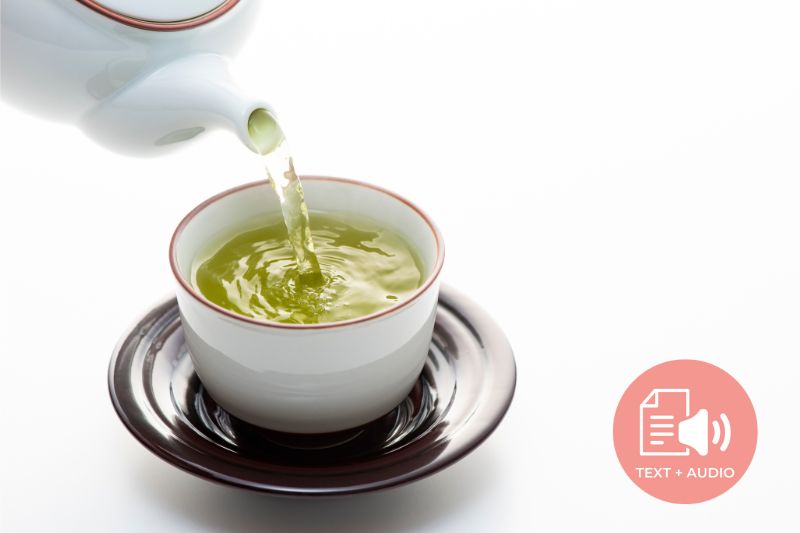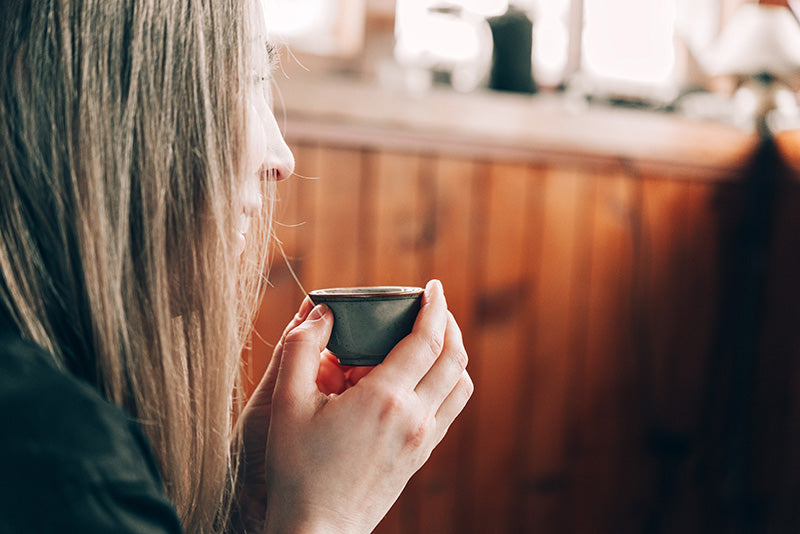Picture two teacups side by side. The first holds vibrant jade-green liquid with an oceanic, grassy aroma—savory-sweet umami that refreshes and focuses. The second contains golden amber tea releasing cinnamon warmth and ginger zing—aromatic spice that grounds and comforts. Same ritual, completely opposite flavor experiences. Why?
Japanese green tea and Thai herbal tea represent two distinct flavor philosophies shaped by geography, culture, and processing. Understanding the science and culture behind each deepens your appreciation for both traditions and reveals when to drink each for optimal benefits.
In this exploration, you'll discover why Japanese tea tastes cool and savory, why Thai herbal tea tastes warm and spicy, the chemistry creating each profile, and how to brew both properly. These aren't competing traditions—they're complementary wellness practices that modern tea lovers can embrace simultaneously.

Two Climates, Two Philosophies
Japan: The Umami Island
Japan's temperate climate, volcanic soil, and limited arable land created a strategic focus: perfecting one plant rather than cultivating thousands. Over 75% of Japan's tea production uses a single cultivar called Yabukita—a testament to refinement through repetition. This single-origin obsession, deeply influenced by Zen Buddhism's emphasis on simplicity and subtle complexity, led to innovations that define Japanese tea's signature umami taste.
The shading process—blocking sunlight for 20+ days before harvest—dramatically boosts L-theanine, the amino acid responsible for savory-sweet depth. After harvest, leaves are immediately steamed at 160-180°F for 30-90 seconds, stopping oxidation and locking in that vibrant green color along with delicate umami compounds. The result is oceanic, grassy flavor with a clean finish.
When you sip quality Japanese green tea, you'll taste seaweed or nori-like savory-sweetness, fresh-cut grass notes, and gentle astringency. The mouthfeel is silky and light-bodied. The psychological effect? Cooling, focusing, and calming—perfect for meditation or concentrated work.
Thailand: The Warming Spice Blend
Thailand's tropical monsoon climate supports over 15,000 plant species, creating abundant biodiversity. Thai herbalists developed "samunprai" (สมุนไพร)—the philosophy of combining 10-15+ medicinal herbs into polyherbal formulas. Unlike Japan's single-plant perfection, Thai tradition celebrates complexity through carefully calibrated blends where each herb plays a specific role.
Processing involves roasting and drying techniques that concentrate volatile aromatic oils and caramelize natural sugars. Traditional blends combine cinnamon, ginger, star anise, black galangal, sandalwood, and nutmeg—each contributing unique aromatic signatures. The result is warming spice with sweet finish and no bitterness.
Your first sip delivers cinnamon-forward warmth, ginger's sharp heat, and star anise's sweet licorice notes. The warming sensation spreads through your chest—not just psychological but physical heat from compounds that stimulate circulation. The mouthfeel is medium-bodied and smooth. The effect? Warming, grounding, and relaxing.
Modern practitioners like Tranquil Siam continue this samunprai tradition, preserving authentic Thai herbal blending methods that create these complex warming flavors.

The Flavor Chemistry
Japanese Green Tea: The Umami Science
L-theanine sits at the heart of Japanese green tea's distinctive taste. This amino acid, found almost exclusively in tea plants, creates that savory-sweet "brothy" umami flavor. Shading increases L-theanine by 2-3 times normal levels, concentrating umami to extraordinary degrees in premium teas like Gyokuro and Matcha. L-theanine partners with caffeine to create "calm alertness"—focused mental energy without jitters—by promoting alpha brain wave activity associated with relaxed concentration.
Catechins, particularly EGCG (epigallocatechin gallate), make up to 60% of the tea's antioxidant content and provide gentle astringency—that slight drying sensation adding complexity when balanced with umami. Too many catechins create harsh bitterness; too few taste flat. Japanese processing preserves the perfect balance.
Chlorophyll gives that vibrant green color and contributes fresh, grassy taste while creating a psychological cooling effect. The steaming process preserves chlorophyll that would otherwise break down during oxidation.
The steaming itself—160-180°F for 30-90 seconds—stops enzyme activity immediately, preventing fermentation and oxidation. This preserves delicate umami compounds that would transform into different flavors if allowed to oxidize. Chinese green teas, pan-fired instead of steamed, undergo different chemical changes creating nuttier, less umami-forward profiles.
The taste result? A "cool" sensation from psychological association with bright green color and light astringency that cleanses your palate. "Oceanic" umami reminiscent of dashi broth or seaweed. Refreshing, clean finish with minimal sweetness and maximum subtlety.

Thai Herbal Tea: The Warming Science
Cinnamaldehyde from cinnamon creates sweet-spicy aroma and actual warming sensation—not just taste but physical warmth through stimulated circulation. This compound has natural antimicrobial and anti-inflammatory properties that traditional Thai herbalists valued long before modern science explained why.
Gingerol from ginger contributes sharp, pungent heat that makes your mouth tingle. It's thermogenic, meaning it actually raises body temperature slightly by stimulating circulation. This isn't psychological warmth—it's measurable physical heat. Traditional Thai medicine recognized ginger as warming and digestive support, observations modern research continues validating.
Anethole from star anise brings sweet licorice notes that balance sharper spices, adding aromatic depth and natural sweetness without sugar. In traditional formulas, star anise harmonizes other flavors.
Essential oils from multiple herbs create aromatic layers. Black galangal adds traditional vitality support with distinctive sharp, pine-like notes. Sandalwood contributes woody, grounding aromas. Ginseng, when included, adds earthy complexity. Each essential oil has different molecular weight and volatility, releasing at different rates during steeping for an evolving aromatic experience.
Modern testing validates what Thai healers knew intuitively—specific herb ratios create optimal flavor balance and therapeutic synergy.
Roasting and drying concentrate these volatile compounds by removing moisture, intensifying flavor without adding anything. Roasting also caramelizes natural sugars, creating sweetness without sweeteners. This concentration creates "warming" sensation through compound density—more cinnamaldehyde, gingerol, and essential oils per gram means more intense flavor and physical warmth.
The taste result? "Warm" from spices that actually stimulate circulation. "Aromatic" from essential oils creating multi-dimensional scent and flavor. "Comforting" from sweet-spice balance. No bitterness or astringency possible.

Brewing Guide: Temperature & Timing
Japanese Green Tea
Temperature is critical. Sencha needs 160-170°F—too hot extracts bitter catechins. Premium Gyokuro requires even cooler water at 140-150°F to maximize umami while minimizing bitterness. Matcha works best around 175°F when whisked into suspension.
Steeping time matters equally. First infusion: 60-90 seconds for balanced extraction. Second infusion: only 30 seconds since leaves are already opened. You can re-steep quality leaves 2-3 times, each revealing slightly different nuances.
Tasting notes: Look for seaweed or nori flavor signaling proper umami, fresh grass, vegetal notes, and sweet aftertaste lingering minutes after swallowing—the sign of high L-theanine content. Avoid strong bitterness (over-steeped or too hot) and sour notes (old tea).
Best time: Morning or afternoon when you need focused mental energy. The gentle caffeine with L-theanine creates calm alertness perfect for work, study, meditation, or creative tasks. Avoid after 5pm if caffeine-sensitive.
Thai Herbal Tea
Temperature: hotter is better. Use boiling water at 212°F to fully extract aromatic essential oils. No bitterness risk since there are no catechins or tannins to over-extract.
Steeping time: be generous. While 5-7 minutes is minimum, optimal extraction happens at 10-15 minutes. Unlike Japanese green tea where longer steeping creates bitterness, Thai herbal tea only becomes more flavorful and aromatic. You can steep even longer without negative effects. Typically all flavor releases in first steep, so less benefit to reusing herbs.
Tasting notes: Look for cinnamon-forward warmth, ginger heat, star anise sweetness, and layered complexity—not one dominant flavor but harmonious evolution. Quality indicator: warming sensation spreading through chest and lingering aromatic finish continuing after you've finished.
Best time: Evening perfection since it's completely caffeine-free. Ideal for after-dinner relaxation or winding-down rituals before bed. The warming aromatics promote physical relaxation without interfering with sleep. Unlike Japanese green tea's time restrictions, enjoy anytime—morning, afternoon, or night.
Tea Stacking for Balance
Modern tea lovers don't have to choose. Consider complementary daily routine: Japanese green tea in morning provides mental clarity and gentle metabolic support. Thai herbal tea in evening offers physical relaxation and warming comfort. Together, they provide balanced wellness throughout your day—mental focus when needed, physical relaxation when it's time to rest.

Health Benefits by Flavor
Japanese Green Tea: Mind & Metabolism
The umami you taste directly correlates with wellness benefits. L-theanine creating savory-sweet depth also modulates alpha brain wave activity, promoting calm focus and stress reduction. Combined with caffeine, it improves cognition and attention without the anxiety coffee can trigger. Research published in The Journal of Nutrition has documented these cognitive benefits extensively.
EGCG antioxidants responsible for gentle astringency support metabolism and fat oxidation, with studies suggesting cardiovascular health benefits. The chlorophyll contributing to bright green color has alkalizing and detoxification properties valued in traditional wellness practices.
The flavor itself matters for wellness. Refreshing taste encourages hydration throughout the day. Umami satisfies savory cravings without calories, potentially helping with appetite management. Light mouthfeel pairs well with meals without overwhelming food flavors.
Best for: Mental clarity and focus, metabolism support, morning and afternoon energy boost.
Thai Herbal Tea: Body & Comfort
The warming spices deliver specific wellness support. Cinnamon's cinnamaldehyde helps balance blood sugar response and provides anti-inflammatory benefits while supporting healthy circulation. Ginger's gingerol offers digestive comfort, supports muscle and joint wellness, and creates thermogenic warmth. Star anise contributes digestive support and antimicrobial properties while its aromatherapeutic effects uplift mood.
The polyherbal synergy—multiple herbs working together—creates broader wellness spectrum than single ingredients alone. Research from Thailand's Mahidol University studying traditional medicine validates what Thai herbalists knew intuitively: carefully balanced herbal formulas create effects greater than the sum of individual parts.
The warming sensation itself provides wellness benefits. Physical warmth is stress-reducing and comforting, activating relaxation responses in your nervous system. Aromatic compounds impact mood through smell's direct connection to emotion centers in your brain—natural aromatherapy through tea drinking. Being caffeine-free supports better sleep rather than interfering with it.
Best for: Physical relaxation and comfort, digestive wellness, evening rituals, anytime caffeine-free warmth.

Conclusion: Embracing Two Flavor Worlds
Japanese tea culture refined simplicity into art—cooling umami extracted from single-plant perfection. Thai herbal tradition celebrated abundance—warming spices blended from biodiversity into polyherbal wisdom. Both achieve wellness and mindfulness through completely opposite flavor paths. Neither is better; they're complementary approaches modern tea lovers can embrace simultaneously.
Consider making both part of your daily ritual. Start mornings with Japanese green tea's focused energy. End evenings with Thai herbal tea's relaxed comfort. Together, they provide balanced mind and body wellness.
Try tasting both side by side to notice how differently your palate responds to oceanic umami versus cinnamon-ginger warmth. Experiment with brewing temperatures to discover how small adjustments reveal different nuances. Pay attention to which resonates with different times of day.
Whether you crave jade-green umami or golden warming spices, you're connecting with centuries-old traditions. Each cup carries the wisdom of tea masters and herbalists who understood that flavor and function are inseparable. Which flavor philosophy speaks to you today?
Get Free Bonus Books

Sign up for free to the Green Tea Club to get advice and exclusive articles about how to choose Japanese Tea, and tips, tricks, and recipes for enjoying Japanese tea.
About the author
Kei Nishida
Author, CEO Dream of Japan
Certification: PMP, BS in Computer Science
Education: Western Washington University
Kei Nishida is a passionate Japanese green tea connoisseur, writer, and the founder and CEO of Japanese Green Tea Co., a Dream of Japan Company.
Driven by a deep desire to share the rich flavors of his homeland, he established the only company that sources premium tea grown in nutrient-rich sugarcane soil—earning multiple Global Tea Champion awards.
Expanding his mission of introducing Japan’s finest to the world, Kei pioneered the launch of the first-ever Sumiyaki charcoal-roasted coffee through Japanese Coffee Co. He also brought the artistry of traditional Japanese craftsmanship to the global market by making katana-style handmade knives—crafted by a renowned katana maker—available outside Japan for the first time through Japanese Knife Co.
Kei’s journey continues as he uncovers and shares Japan’s hidden treasures with the world.
Learn more about Kei








